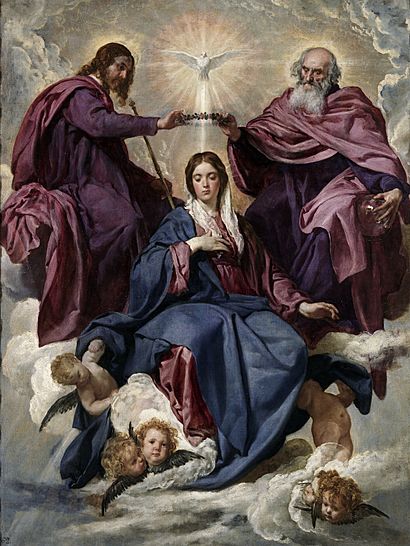Coronation of the Virgin (Velázquez) facts for kids
Quick facts for kids The Coronation of the Virgin |
|
|---|---|
 |
|
| Artist | Diego Velázquez |
| Year | 1641-1644 |
| Medium | Oil on canvas |
| Dimensions | 176 cm × 124 cm (69 in × 49 in) |
| Location | Museo del Prado, Madrid |
The Coronation of the Virgin is a beautiful painting by the famous Spanish artist Diego Velázquez. He created this artwork between 1635 and 1636 using oil paints on a canvas. The painting shows a special moment: the Holy Trinity (God the Father, Jesus, and the Holy Spirit) placing a crown on the head of the Virgin Mary. This type of artwork, focusing on the Virgin Mary, is common in Marian art. Today, you can see this painting at the Museo del Prado in Madrid, Spain.
The painting was likely ordered for the private chapel of Elisabeth of France, who was the queen of Spain and wife of Philip IV of Spain. It was placed in the Real Alcázar of Madrid, a royal palace. Some art experts believe that the person who posed for Mary in this painting might be the same person Velázquez used for his other famous work, the Rokeby Venus.
Contents
What the Painting Shows
Velázquez is mostly known for his amazing portraits, but The Coronation of the Virgin is one of his rare religious paintings. It stands out because it looks very natural and simple, unlike many other religious artworks from that time.
The Painting's Shape and Meaning
The way the painting is put together forms an upside-down triangle. This shape makes the painting feel balanced and harmonious. It also looks a bit like a heart, which is a clever way to connect with the viewer's feelings.
The Figures in the Painting
The main person in the painting is the Virgin Mary. She looks modest, respectful, and emotional, with her eyes looking down. She has a straight nose and curved lips. Mary points to her own heart, which helps to show the idea of the painting looking like a heart and makes people feel more connected to the religious scene.
On the right side of the painting, you see God the Father, shown as a wise old man. On the left, there is Jesus Christ with long hair. Together, they hold a crown above Mary's head. In the very middle, the Holy Spirit is shown as a white dove. The heads of God the Father, Jesus, and the dove are all at the same level. This shows that they are all equal parts of the Holy Trinity.
You'll also notice many small, cute cherubs (angel-like figures) around the Virgin Mary at the bottom of the painting. Velázquez painted them so well that they can be compared to the cherubs painted by Bartolomé Esteban Murillo, another famous artist known for his cherub artworks.
Colors Velázquez Used
Velázquez mainly used shades of blue and purple in this painting. He also used special red colors called carmines, especially Venetian carmine, instead of the usual reds. He followed advice from his teacher, Pacheco, who wrote about colors in his book Arte de la Pintura. Velázquez used these colors even though he was already a very famous artist when he painted this work.
Who Posed for Mary?
Some art historians, like José López-Rey, have noticed that the model for Mary in this painting looks very similar to the models Velázquez used for other works, like the Rokeby Venus and The Fable of Arachne. López-Rey suggested that Velázquez might have used the same person, sketch, or idea of a beautiful young woman for all these paintings. However, he believed Velázquez still created different images: one showing divine (heavenly) beauty and the other earthly beauty.
See also
 In Spanish: Coronación de la Virgen (Velázquez) para niños
In Spanish: Coronación de la Virgen (Velázquez) para niños
- List of works by Diego Velázquez
Sources
- The Coronation of the Virgin, Museo del Prado

